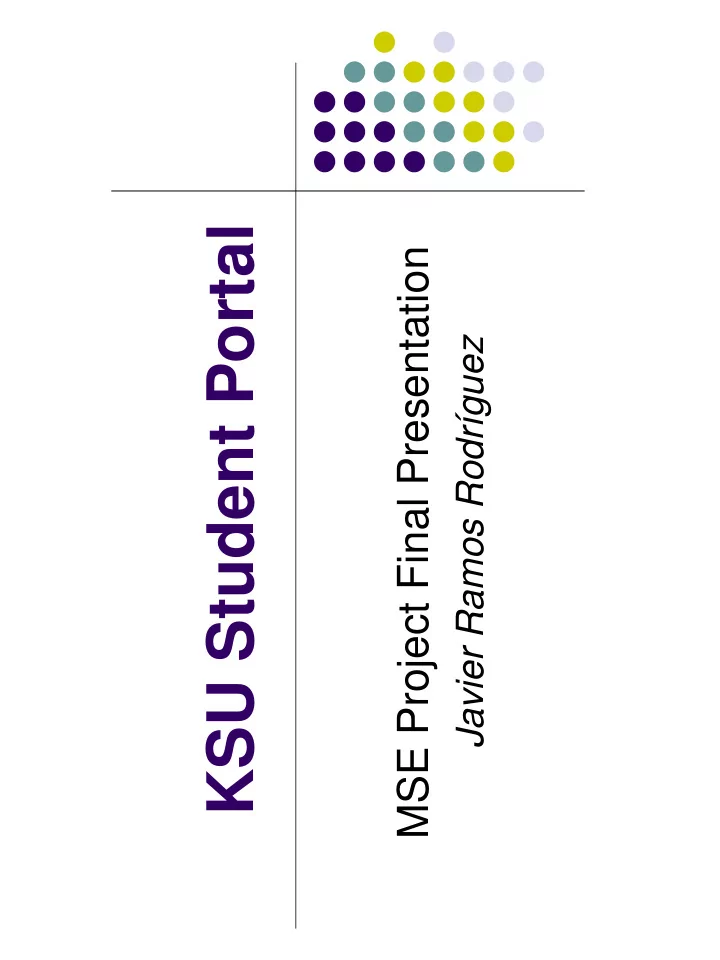

KSU Student Portal MSE Project Final Presentation Javier Ramos Rodríguez
OUTLINE � Introduction � Implementation Phase � Phase 2 Design � Process � Implementation Overview � Phase 3 Implementation Design � Issues � Features � Demo � Project Plan � Test Plan � Conclusions � References
Introduction � KSU Student Portal � Web Application � Data Bound � Heavyweight Approach � Phase 3: Project Implementation � Bottom-Up Approach � Data Entities � Top-Down Approach � Facade Methods
Phase 2 Design User View RegisterUI showRegForm() showResults() MainUI MainUIController Use the Information provided by showLoginForm() checkLogin() validateInput() the Design and proceed with the showResults() checkResults() register() RegisterUIController system implementation. showWelcome() submit() validateFields() showResults() More Details will be added to the application. Model ModelFacade UserControl checkLogin() checkLogin() showResults() registerUser() registerUser() persist() getUserList() getUserList() returnResults() getUserProfile() getUserProfile() getBlogEntries() searchUsers() searchUsers() deleteUser() getPublicEvents() viewPublicEvent() updateProfile() deleteUser() updateProfile() createEvent() getEvents() deleteEvent() AppUser
Process Phase 1 : � Requirements Analysis 1. Use Case Diagram 2. Use Case Specification 3. E-R Diagram 4.
Process Phase 2: � Use Case Diagram Revision 1. Sequence & Collaboration Diagrams 2. Class Diagram 3. E-R Revision 4. UML Data Model 5. Relational Schema 6. UML Design Revision 7. Formal Specification 8.
Process Phase 3: � Implement Relational Schema in Database 1. Create Entity Beans From Tables 2. Implement Relations Between the Entity 3. Beans Write initial EJB-QL Queries 4. Create Session Beans 5. Create Model Facade 6. Publish Methods 7. Test Methods 8.
Implementation Overview � There are more Session Beans than Control Classes from Design � Load Balance � Loosy Coupled � Session Beans perform the business logic accessing to the Entity Beans � Model Facade is the entry point to the system. � Model Controller � No Business logic, it relies on the EJBs � Session Facade, Business Delegate
Implementation Overview � Entity Beans � AppUser � Blog, Blog Entry � Message � Article, Event, Link � Profile, Filter � Course, Language, Country, State
Implementation Overview � Session Beans: � AppUserSessionBean � BlogSessionBean � MessageSessionBean � ArticleSessionBean, EventSessionBean, LinkSessionBean � FilterSessionBean � UtilSessionBean � Model Facade
Implementation Design
Issues � Object Relationships � OO Schema = Relational Schema � Lazy vs. Eager Fetching � Handling Null Values (Filter) � EJB-QL (Avoid Using SQL => Portability)
Features � Distribute System � Layers Pattern � Database Independent: ORM + EJB-QL � Safe (No Arrays) and clean code. � New Technologies: EJB 3.0, Java 5 � Portable � Pure OO � Security: Encrypted passwords, code analyzers � View: MVC, JSF + ADF Components, JavaScript, CSS, Multiple Languages…
Demo
Project Plan � What has been done � Requirements Analysis: 100% � System Design: 100% � Implementation Design: 70% � Coding: � Database Layer: 100% � Model Layer: 85% � View Layer: 2% � Client layer: 0%
Project Plan � What remains to be done � May: Finish Model, Start View � June: View (JSP pages) � July: Testing, Documentation, Enhance View
Test Plan � System was build with testing in mind. � Safe environment. � Test Plan: � Unit Testing: Junit � Integration Tests � Other Tools ( FindBugs )
Conclusions � Goals � Mimic a real world enterprise application. � Full software Cycle. � Test New Technologies. � Learn J2EE Platform. � Solve problems using Javadoc and specifications.
Conclusions � EJB 3.0 � Easier to use than EJB 2.0. � Perform the most tedious work for you (network, security issues). � Standard. � Portable. � Immature, lack of documentation � Different interpretations of the specification. � Still difficult to use.
Conclusions � JSF � Drag & Drop UI Design for Web Applications. � Easy to use. � MVC pattern. � Validation, Internationalization � Immature � MVC not as pure as with Struts
References � www.uml.org � www.rational.com � Applying UML and Patterns - An Introduction to Object-Oriented Analysis and Design and the Unified Process, Craig Larman � The Rational Unified Process: An Introduction (2nd Edition), Philippe Kruchten � Java Server Faces (2004), Hans Bergsten
Recommend
More recommend